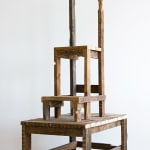Theaster Gates USA, b. 1973
Shoe Shine with Old Growth Pedestal (Him), 2012
Reclaimed wood and iron
Shoe Shine: 76 x 22 x 33 in
Base: 26 x 36 x 54 1/2 in
Base: 26 x 36 x 54 1/2 in
2783
Further images
Theater Gates pioneered a process of mobilizing art to create real social change by tearing down abandoned homes in neglected Black, urban neighborhoods, reusing their materials to create art objects,...
Theater Gates pioneered a process of mobilizing art to create real social change by tearing down abandoned homes in neglected Black, urban neighborhoods, reusing their materials to create art objects, and then using proceeds from art sales to build new homes in those neighborhoods and to buy more abandoned homes so the process could begin again. The art objects he makes evoke comparisons to Geometric Abstraction for their simple, pared down forms, while the materials suggest a relationship to Arte Povera. The content in the work, meanwhile, is unmistakably related to the history of Black America. This work belongs to a series of sculptures Gates refers to as "thrones." Using reclaimed housing materials, he has constructed a geometric sculpture that resembles a classic shoe shine stand, in which one could imagine a privileged white man sitting comfortably while a Black man, hunched over before him, earns his living shining his shoes. The art historical relevance of the piece is not lost, as a Black artist such as Gates would never have been invited to participate in the racially segregated art market of the 1960s and 70s, when artists such as Donald Judd and Carl Andre were making geometric, Minimal forms such as the ones incorporated into this work.
Provenance
Artist Studio, ChicagoKavi Gupta, Chicago





